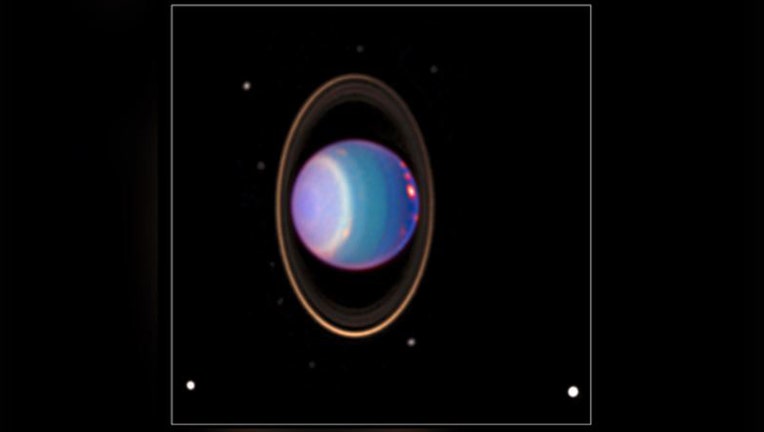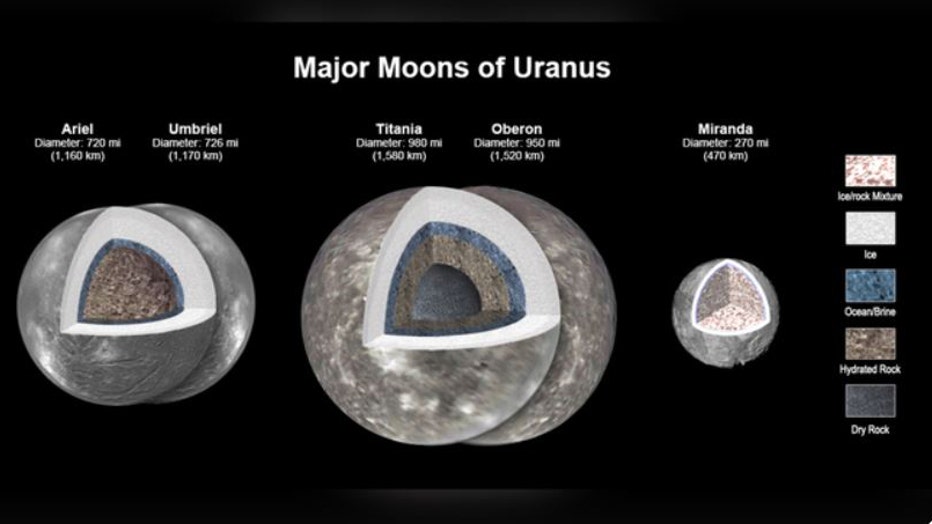Oceans could lurk beneath icy surface of four of Uranus' moons, study shows

Uranus is surrounded by its four major rings and 10 of its 27 known moons in this color-added view that uses data taken by the Hubble Space Telescope in 1998. (NASA/JPL/STScI / NASA)
NASA scientists have concluded that four of Uranus’ largest moons likely contain an ocean layer between their cores and icy crusts after re-analyzing data from the Voyager spacecraft and new computer data.
This study, according to NASA, is the first to detail the evolution of the interior makeup and structure of all five large moons – Ariel, Umbriel, Titania, Oberon and Miranda.
Uranus has at least 27 moons, with the four largest ranging in size from Ariel, at 720 miles across, to Titania, which is 980 miles across.
NASA says that scientists have long thought that Titania would be the most likely to retain internal heat caused by radioactive decay, given its size. And the others were widely considered too small to retain the heat necessary to keep an internal ocean from freezing.
NASA DEVELOPING A SNAKE-LIKE ROBOT TO SLITHER OVER ONE OF SATURN’S 83 MOONS

New modeling shows that there likely is an ocean layer in four of Uranus’ major moons: Ariel, Umbriel, Titania, and Oberon. Miranda is too small to retain enough heat for an ocean layer. (NASA/JPL-Caltech / NASA)
The study, published in the Journal of Geophysical Research, suggests Ariel and Umbriel could host oceans beneath the surface less than 18 miles thick, and Titania and Oberon could host an ocean less than 30 miles thick.
NASA says the new details could inform how future missions may investigate moons, but also goes beyond Uranus, according to the study’s lead author Julie Castillo-Rogez, of NASA’s Jet Propulsion Laboratory in Southern California.
"When it comes to small bodies – dwarf planets and moons – planetary scientists previously have found evidence of oceans in several unlikely places, including the dwarf planets Ceres and Pluto, and Saturn’s moon Mimas," she said in a news release. "So there are mechanisms at play that we don’t fully understand. This paper investigates what those could be and how they are relevant to the many bodies in the solar system that could be rich in water but have limited internal heat."
WATCH OUT FOR THESE ASTRONOMICAL EVENTS IN 2023
The scientists made these conclusions by revisiting the findings from the Voyager 2 flybys of Uranus in the 1980s and from observations made here on Earth.
The study’s authors then were able to build computer models with additional information from NASA’s Galileo, Cassini, Dawn and New Horizons spacecraft, including insights into the chemistry and geology of Saturn’s moons Enceladus, Pluto and its moon Charon and Ceres – all of which have icy landscapes that are about the same size as the Uranian moons, NASA said.
By learning more about the composition of the oceans, NASA adds that scientists can learn about materials that may be found on the moons’ icy surfaces, too, depending on whether materials from beneath the surface were pushed up from below by geological activity.
NASA says there’s telescope-based evidence that at least one of Uranus’ moons, Ariel, has materials that flowed onto its surface, possibly from icy volcanoes, relatively recently.
WHAT IS THE ‘TORINO SCALE’ WHEN IT COMES TO ASTEROID IMPACT RISK?
Miranda, the innermost and fifth-largest moon, also has relatively new features. That suggests it may have had enough heat to maintain an ocean.
However, NASA says that recent thermal modeling found Miranda is unlikely to have hosted water for a long period since it loses heat too quickly and is likely frozen.
Castillo-Rogez says there are still many unanswered questions about Uranus’ large moons, and more research needs to be done.
"We need to develop new models for different assumptions on the origin of the moons in order to guide planning for future observations," she said in the news release.

